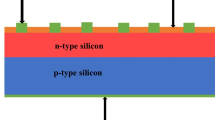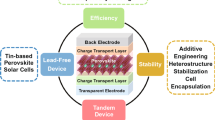Abstract
This work exhibits a new theoretical approach about a 2T Tandem solar cell made of two cells: CFTS/Si. For maximum benefit, careful consideration must be given to the selection and performance enhancement of both cells. In order to achieve good results, the bottom and top cells are independently analyzed and optimized to set the best structure for each one of them. Two terminal tandem solar cells are very effective in converting energy. However, one of the main limitations of the 2T terminals model is the circulation of the lowest current density since it is similar to an electric series connection between the sub cells. In this paper we tried to define a current matching point with a good current density. The two SC structures (Top and Bottom) under investigation generated impressive performances of about 24.06% and 22.04%, respectively. The evaluation of the tandem Cu2FeSnS4-on-c-Si solar cell produced the following simulation results: Voc= 1.81 V, Jsc= 22.22 mA/cm2, and Fill Factor=87.61% with a conversion efficiency of 35.23 %. The results demonstrate a thorough analysis of both prospective single-cell performance parameters and tandem device architecture.
Similar content being viewed by others
Data availability
There is no additional data available for the proposed work.
Code availability
There is no code available for the proposed work.
Abbreviations
- μn (cm2/Vs):
-
Electron mobility
- μp (cm2/Vs):
-
Hole mobility
- ND (cm−3):
-
Shallow uniform donor density
- NA (cm−3):
-
Shallow uniform acceptor density
- Nt (cm−3):
-
Defect density
- φ(eV):
-
Work function of the metal contact
- Se(cm/s):
-
Velocity of recombination in the surface for electrons
- Sh(cm/s):
-
Surface recombination velocity for holes
- \({V}_{th}=\frac{KT}{q}\) :
-
Thermal voltage
- A (Taken as 2):
-
Ideality factor
- λ (nm):
-
Wavelength
- α (cm-1):
-
Absorption coefficient
- Voc(V):
-
Open circuit voltage
- Jsc(mA/cm2):
-
Short circuit current density
- Eg(eV):
-
Band gap
- χ (eV):
-
Electron affinity
- εr :
-
Dielectric permittivity (relative)
- Nc (cm−3):
-
CB effective density of states
- Nv (cm−3):
-
VB effective density of states
- K :
-
Boltzmann constant
- q :
-
Elementary charge
- T:
-
Temperature at 300K,
- Eg(eV):
-
Band gap
- Cu2FeSnS4 :
-
Copper Iron Tin Sulfur
- CdS:
-
Cadmium Sulfide
- ITO :
-
Indium Tin Oxide
- Si:
-
Silicon
- BSF:
-
back surface field
- PCE(ɳ(%)):
-
Power Conversion Efficiency
- FF(%):
-
Fill Factor
- SC :
-
Solar Cell
- PV:
-
Photovoltaic
References
Al-Hattab M, Moudou L, Khenfouch M et al (2021) Numerical simulation of a new heterostructure CIGS/GaSe solar cell system using SCAPS-1D software. Sol Energy 227:13–22. https://doi.org/10.1016/j.solener.2021.08.084
Jackson P, Hariskos D, Lotter E et al (2011) New world record efficiency for Cu(In,Ga)Se2 thin-film solar cells beyond 20%. Prog Photovoltaics Res Appl 19:894–897. https://doi.org/10.1002/pip.1078
Morales-Acevedo A, Hernández-Como N, Casados-Cruz G (2012) Modeling solar cells: A method for improving their efficiency. Mater Sci Eng B Solid-State Mater Adv Technol 177:1430–1435. https://doi.org/10.1016/j.mseb.2012.01.010
Kaelin M, Rudmann D, Tiwari AN (2004) Low cost processing of CIGS thin film solar cells. Sol Energy 77:749–756. https://doi.org/10.1016/j.solener.2004.08.015
Ouedraogo S, Sam R, Ouedraogo F, et al (2013) Optimization of Copper Indium Gallium Di-Selenide (CIGS) based solar cells by back grading. IEEE AFRICON Conf. https://doi.org/10.1109/AFRCON.2013.6757813
Savita Kashyap, Jaya Madan, Rahul Pandey and RS (2021) Process and device simulations aimed at improving the emitter region performance of silicon PERC solar cells. J Micromechanics Microengineering 32:025001
Meher SR, Balakrishnan L, Alex ZC (2016) Analysis of Cu2ZnSnS4/CdS based photovoltaic cell: A numerical simulation approach. Superlattices Microstruct 100:703–722. https://doi.org/10.1016/j.spmi.2016.10.028
Ait Abdelkadir A, Oublal E, Sahal M, Gibaud A (2022) Numerical simulation and optimization of n-Al-ZnO/n-CdS/p-CZTSe/p-NiO (HTL)/Mo solar cell system using SCAPS-1D. Results Opt 8:100257. https://doi.org/10.1016/j.rio.2022.100257
Hassanien AS, El Radaf IM (2020) Optical characterizations of quaternary Cu2MnSnS4 thin films: Novel synthesis process of film samples by spray pyrolysis technique. Phys B Condens Matter 585:412110. https://doi.org/10.1016/j.physb.2020.412110
Pansuriya T, Malani R, Kheraj V (2022) Investigations on the effect of buffer layer on CMTS based thin film solar cell using SCAPS 1-D. Opt Mater (Amst) 126:112150. https://doi.org/10.1016/j.optmat.2022.112150
Cui Y, Deng R, Wang G, Pan D (2012) A general strategy for synthesis of quaternary semiconductor Cu 2MSnS 4 (M = Co 2+, Fe 2+, Ni 2+, Mn 2+) nanocrystals. J Mater Chem 22:23136–23140. https://doi.org/10.1039/c2jm33574c
Nefzi C, Souli M, Cuminal Y, Kamoun-Turki N (2018) Effect of sulfur concentration on structural, optical and electrical properties of Cu2FeSnS4 thin films for solar cells and photocatalysis applications. Superlattices Microstruct 124:17–29. https://doi.org/10.1016/j.spmi.2018.09.033
Ozel F (2016) Earth-abundant quaternary semiconductor Cu2MSnS4 (M = Fe, Co, Ni and Mn) nanofibers: Fabrication, characterization and band gap arrangement. J Alloys Compd 657:157–162. https://doi.org/10.1016/j.jallcom.2015.10.087
Guan H, Shen H, Jiao B, Wang X (2014) Structural and optical properties of Cu2FeSnS4 thin film synthesized via a simple chemical method. Mater Sci Semicond Process 25:159–162. https://doi.org/10.1016/j.mssp.2013.10.021
Chatterjee S, Pal AJ (2017) A solution approach to p-type Cu2FeSnS4 thin-films and pn-junction solar cells: Role of electron selective materials on their performance. Sol Energy Mater Sol Cells 160:233–240. https://doi.org/10.1016/j.solmat.2016.10.037
Sarker S, Islam MT, Rauf A et al (2021) A SCAPS simulation investigation of non-toxic MAGeI3-on-Si tandem solar device utilizing monolithically integrated (2-T) and mechanically stacked (4-T) configurations. Sol Energy 225:471–485. https://doi.org/10.1016/j.solener.2021.07.057
Punarja Kevin, M. Azad Malik PO (2015) The AACVD of Cu2FeSn(SxSe1-x)4: Potential Environmentally Benign Solar Cell Materials. R Soc Chem peer. https://doi.org/10.1039/C5NJ01198A
El Saeedy HI, Yakout HA, El Sayed MT (2020) Fabrication and growth of linear and nonlinear optical behaviour of Cu2FeSnS4 spherical nanostructured thin films. Appl Phys A Mater Sci Process 126:. https://doi.org/10.1007/s00339-020-3458-z
Hou H, Guan H, Li L (2017) Synthesis of Cu2FeSnS4 thin films with stannite and wurtzite structure directly on glass substrates via the solvothermal method. J Mater Sci Mater Electron 28:7745–7748. https://doi.org/10.1007/s10854-017-6469-6
Varku S, Pradhan KP, Routray S (2022) Performance limitation of Cu2FeSnS4 solar cell: Understanding impact of density of defect states. Opt Mater (Amst) 133:112885. https://doi.org/10.1016/j.optmat.2022.112885
Khattak YH, Baig F, Ullah S et al (2018) Numerical modeling baseline for high efficiency (Cu2FeSnS4) CFTS based thin film kesterite solar cell. Optik (Stuttg) 164:547–555. https://doi.org/10.1016/j.ijleo.2018.03.055
Oublal E, Sahal M, Ait Abdelkadir A (2022) New theoretical analysis of a novel hetero-junction SnS/CdS solar cell with homo-junction P–P+ in the rear face-numerical approach. Curr Appl Phys 39:230–238. https://doi.org/10.1016/j.cap.2022.05.008
Kashyap S, Pandey R, Madan J, Sharma R (2020) Design and Simulation of a-Si:H/PbS Colloidal Quantum Dots Monolithic Tandem Solar Cell for 12% Efficiency. Phys Status Solidi Appl Mater Sci 217:. https://doi.org/10.1002/pssa.202000252
Oublal E, Al-hattab M, Ait A, Sahal M (2022) New numerical model for a 2T-tandem solar cell device with narrow band gap SWCNTs reaching efficiency around 35 %. Solar Energy 246:57–65. https://doi.org/10.1016/j.solener.2022.09.036
Al-Hattab M, Oublal E, Sahal M et al (2022) Simulation study of the novel Ag2MgSn(S/Se)4 chalcogenide tandem solar device employing monolithically integrated (2T) configurations. Sol Energy 248:221–229. https://doi.org/10.1016/j.solener.2022.11.024
Asaduzzaman M, Bahar AN, Rahman Bhuiyan MM, Habib MA (2017) Impacts of Temperature on the Performance of Cdte Based Thin-Film Solar Cell. IOP Conf Ser Mater Sci Eng 225:. https://doi.org/10.1088/1757-899X/225/1/012274
Islam T, Jani R, Islam AF, et al (2021) Investigation of CsSn0.5Ge0.5I3-on-Si Tandem Solar Solar Device Utilizing SCAPS Simulation. IEEE Trans Electron Devices, 68, 2, Febr 2021 68:618–625
Jafarzadeh F, Aghili H, Nikbakht H, Javadpour S (2022) Design and optimization of highly efficient perovskite/homojunction SnS tandem solar cells using SCAPS-1D. Sol Energy 236:195–205. https://doi.org/10.1016/j.solener.2022.01.046
Mohammadnejad S, Baghban Parashkouh A (2017) CZTSSe solar cell efficiency improvement using a new band-gap grading model in absorber layer. Appl Phys A Mater Sci Process 123:0. https://doi.org/10.1007/s00339-017-1371-x
Vallisree S, Thangavel R, Lenka TR (2018) Theoretical investigations on enhancement of photovoltaic efficiency of nanostructured CZTS/ZnS/ZnO based solar cell device. J Mater Sci Mater Electron 29:7262–7272. https://doi.org/10.1007/s10854-018-8715-y
Acknowledgments
Authors’ acknowledgments are dedicated to Mr. Marc Burgelman for assuring the availability of SCAPS-1D software.
Author information
Authors and Affiliations
Contributions
Mohamed Al-Hattab, Essaadia Oublal ,L'houcine Moudou and Younes Chrafih, analyze the device structure, simulation study and drafted the manuscript. Omar Bajjou, Mustapha Sahal and Khalid Rahmani updated the draft file of manuscript.
Corresponding author
Ethics declarations
Ethics approval
No ethics approval is required for proposed work.
Consent to participate
For proposed work no consent to participate is required.
Consent for publication
We all the authors are agree to publish the manuscript content. The proposed work is original and have not submitted or considered for publication elsewhere.
Competing interests
The authors declare no competing interests.
Additional information
Publisher’s note
Springer Nature remains neutral with regard to jurisdictional claims in published maps and institutional affiliations.
Rights and permissions
Springer Nature or its licensor (e.g. a society or other partner) holds exclusive rights to this article under a publishing agreement with the author(s) or other rightsholder(s); author self-archiving of the accepted manuscript version of this article is solely governed by the terms of such publishing agreement and applicable law.
About this article
Cite this article
Al-Hattab, M., Oublal, E., Chrafih, Y. et al. Novel Simulation and Efficiency Enhancement of Eco-friendly Cu2FeSnS4/c-Silicon Tandem Solar Device. Silicon 15, 7311–7319 (2023). https://doi.org/10.1007/s12633-023-02582-5
Received:
Accepted:
Published:
Issue Date:
DOI: https://doi.org/10.1007/s12633-023-02582-5




